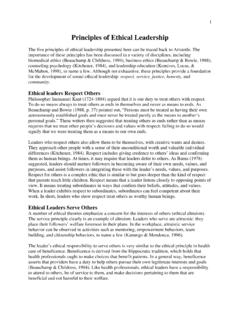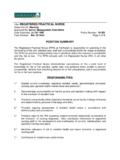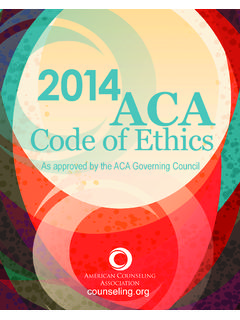Transcription of Implementing Seeking Safety therapy for PTSD …
1 Implementing Seeking Safety therapy for PTSD and substance abuse:Clinical GuidelinesLisa M. Najavits, PhDHarvard Medical School/McLean M. Najavits, PhD is Associate Professor of Psychiatry (Psychology), Harvard MedicalSchool, and Director of the Trauma Research Program in the Alcohol and Drug AbuseTreatment Center at McLean Hospital (Belmont, Massachusetts). She is the author of SeekingSafety: A Treatment Manual for PTSD and Substance Abuse (Guilford Press, New York; 2002)and A Woman s Addiction Workbook (New Harbinger Press; 2002), and over 70 professionalpublications. She is recipient of the 1997 Chaim Danieli Young Professional Award of theInternational Society for Traumatic Stress Studies and the 1998 Early Career ContributionAward of the Society for Psychotherapy Research. She has received four National Institutes ofHealth grants, including an Independent Scientist Award.
2 She is a practicing therapist andpsychotherapy Behavioral Health Recovery Management projectIs an initiative of Fayette Companies, Peoria, ILChestnut Health Systems, Bloomington, ILand The University of Chicago Center for Psychiatric RehabilitationThe project is funded by the Illinois Department of Human Services'Office of Alcoholism and Substance large number of clients in substance abusei treatment have current posttraumaticstress disorder (PTSD), estimated at 33%-59% in women and12%-34% in men [1]. Themajority have a history of trauma and often multiple traumas, such as child abuse, rape, criminalassault, serious accidents, natural disasters, and combat. Yet traditional treatment has notattended to these issues. Most do not receive assessment or treatment of their PTSD [2, 3].
3 Messages in substance abuse treatment such as Don t work on the PTSD until you ve beenclean for a year or Substance abuse is the only problem you need to focus on , while well-intentioned, can be perceived as invalidating of clients trauma history [4]. The 12-stepapproach of Alcoholics Anonymous that dominated 20th century treatment of substance abusehas been very helpful for many [5]. However, clients and clinicians report that when a client hasPTSD, getting clean and sober is a bigger hurdle and such traditional methods may not work aswell [6, 7]. For example, the tendency for PTSD memories and feelings to worsen as clientsget clean is a common phenomenon [8, 9]. Similarly, in the mental health field, messages suchas We can t treat you if you have a substance abuse problem , or more commonly, neglectingto even ask about addiction, have left clients without adequate attention to their substanceabuse.
4 Sadly, clients with the dual diagnosis of PTSD and substance abuse have worseoutcomes than those with either disorder alone [10, 11], and may internalize a sense of failurewhen they do not succeed in standard treatment programs that work for others. Feeling crazy , lazy , or bad is common-- a sense of demoralization, self-blame, and a feeling of somethingbeing terribly wrong with them. [4]. Families and treaters at times may convey such messagesas well: That event happened 20 years ago-- move on already or You re just trying to avoidyour addiction problem by talking about the past . PTSD offers a framework that many clients and clinicians find helpful. It is like a newlens that honors what clients have lived through, encourages empathy and self-understanding,and may increase their motivation to get clean and sober.
5 It can be reassuring to realize thatthey may have abused substances as an attempt to cope with overwhelming emotional pain,and to recognize how common this pattern is. This understanding can move them beyond therevolving door of just more treatment into different treatment. Instead of cycling back throughanother round of standard treatment, they go down a different path. As one client said, I wasrelieved to find I had something with a name. I thought it was just me-- I m crazy. But I can dealwith this I can put down the cocaine and work on what s behind it [12, pg. 81].Unlike some diagnostic labels, PTSD tends to be well-received. Indeed, clients express aclear preference to include treatment of PTSD in substance treatment [13, 14]. Most of all,initial evidence suggests that working on PTSD and substance abuse in an integrated fashionresults in positive outcomes in both of these disorders, as well as related areas.
6 Contrary toolder views, treating both PTSD and substance abuse at the same time appears to help clientswith their substance abuse recovery, rather than derailing them from attaining abstinence [15-20].However, one of the major misconceptions at this point is that PTSD treatmentnecessarily means digging up trauma memories-- telling the story of what happened andprocessing the past. For someone with active substance abuse, there remain significantquestions about when, how, and whether to do such trauma processing work. Such treatmentsgo by many names, including exposure therapy [21], eye movement desensitization andreprocessing [22], mourning [23], the counting method [24], and cognitive processing therapy [25]. Such treatments are an important clinical tool and have shown efficacy for PTSD alone[26].
7 However, in the context of active substance abuse, they may be problematic. Thetraumatic memories may be too emotionally upsetting when clients do not yet have adequatecoping skills to control their impulses. Concerns repeatedly expressed in the literature are thatclients may use substances more, may relapse (if already abstinent), or may increasedangerous behaviors such as self-harm or suicidality [6, 7, 27]. Opening up the Pandora sbox of trauma memories may destabilize clients when they are most in need of themselves may not feel ready for trauma processing early in substance abuserecovery. In a study of exposure therapy by Brady et al. [15], for example, did notcomplete the minimum dose of treatment. (Interestingly, however, the who were able toengage improved in both substance abuse and PTSD symptoms, although it should be notedthat the study ruled out clients with suicidal ideation, thus likely selecting a less severe sample.)
8 An alternative to trauma-processing models that delve into the past are cognitive-behavioral therapy (CBT) coping skills models that focus on the present. Such models providepsychoeducation, teach clients how to decrease symptoms when they flare up, and help themgain control over current life problems. The idea that early recovery treatment should focus onstabilization and Safety has been consistently recommended separately in both the PTSD [23]and substance abuse literatures [28]. It is noteworthy that studies that have directly comparedtrauma-processing models with CBT models show them to be equally helpful [29], althoughsuch comparison studies have not yet been conducted in substance abuse samples. In short, itis not yet clear which clients may benefit from either or both approaches.
9 The field is young inits understanding of these complex Safety fits into the category of present-focused, coping skills approaches. Itwas developed as an integrated treatment for PTSD/substance abuse that can be used in earlyrecovery from both disorders. It does not require the client to delve into the past, although it canbe combined with trauma-processing methods. (Indeed, one study, under Empirical Evidence below, offers positive outcomes for this combination.) Below, the treatment is described, itsempirical results reviewed, and implementation suggestions are FEATURES OF Seeking SAFETYS eeking Safety is described in a treatment manual that offers both a therapist guide andextensive client handouts [4]. A recent book chapter also provides a summary [30]. TheSeeking Safety website, , provides sample topics, articles, and othermaterials that can be directly downloaded.
10 The treatment was first described in a 1996 paper[31], although the treatment evolved considerably since then: from an initial focus on women toboth genders, from group modality to individual as well, and from outpatient to a variety features of Seeking Safety are as follows:Core principles. The treatment is based on five central ideas:(1) Safety as the priority of treatment. The title Seeking Safety expresses itsbasic philosophy: when a person has both substance abuse and PTSD, the most urgent clinicalneed is to establish Safety . Safety is a broad term that includes discontinuing substance use,reducing suicidality and self-harm behavior, ending dangerous relationships (such as domesticabuse and drug using friends), and gaining control over symptoms of both disorders. InSeeking Safety , Safety is taught through Safe Coping Skills, a Safe Coping Sheet, a SafetyPlan, and a report of safe and unsafe behaviors at each session, for example.







